The integrated future of search
Agency and in-house specialist teams need to start working more closely together. This statement is true across all disciplines – from UX to SEO, insights to social media. However, in the context of SEO and Paid Media specifically, in the past (and even now), they have tended to be seen as segregated disciplines.
Yet in recent years there’s been a big effort across the industry to address this, because the results, when teams work together, are clearly better. In this post, I will be focusing on how data can be effectively shared across these specialist areas to make better, data-driven decisions, and to generate better overall search marketing results. At Hallam, we’ve christened this approach “Unified Search”.
How to share data & insights to optimise campaigns more effectively
First and foremost, it’s about sharing data across teams in an efficient and effective way in order to better optimise paid and organic campaigns and generate the best possible return as a whole across both of those channels. I would recommend setting up bespoke Google Data Studio dashboards that pull through the relevant information from Google Ads and Search Console so specialists have the data they need at their fingertips.
Before creating these reports, though, you need to understand how the data can be utilised to boost the performance of campaigns across search, so you understand what data to pull through. The following are particular use cases, but there will be more that could potentially be useful, which may vary from business to business:
1. Use search term report data to help inform organic landing pages & new PPC ad groups
The Google Ads search term report is a goldmine for keyword data. It displays the exact keywords that triggered ads and generated paid traffic to your website.
Reviewing this report will enable you to uncover ideas for new categories or landing pages based on high intent keywords that could be added to the site, which are relevant to your current products and/or services. Alongside this, you could create specific targeted Ads for these keywords, using the new organic landing page/category as the destination URL, or creating specifically crafted PPC landing pages, depending on the requirement. Covering both bases will more effectively build your website’s overall visibility in the search results.
You may also use search term report data to identify search trends for products/services you don’t currently sell. I recommend that you look at this in conjunction with the search query report in Google Analytics which gives you information on what customers who are already on your site are typing into your search bar.
And don’t forget to uncover long-tail questions or phrases that may be optimised for organically as part of your content strategy.
2. Make data-driven budget decisions where necessary
Are your campaigns limited by budget but there is no scope to expand? By combining ranking and click data from Google Search Console with click and cost data from PPC campaigns, you can identify where you currently rank number 1 organically, and how much those keywords are currently costing from a paid perspective.
Now, I’m not saying you should stop bidding on the terms where you rank number 1 organically in a blanket-approach – that would be foolhardy. However, if you need to save budget and you are spending money on keywords that aren’t converting very well and where you already have strong organic visibility, then in a necessary cost-saving exercise these could potentially be the first to be culled, so that budget can be diverted elsewhere (likely to keywords/topics where you currently don’t have organic visibility, but which do convert well).
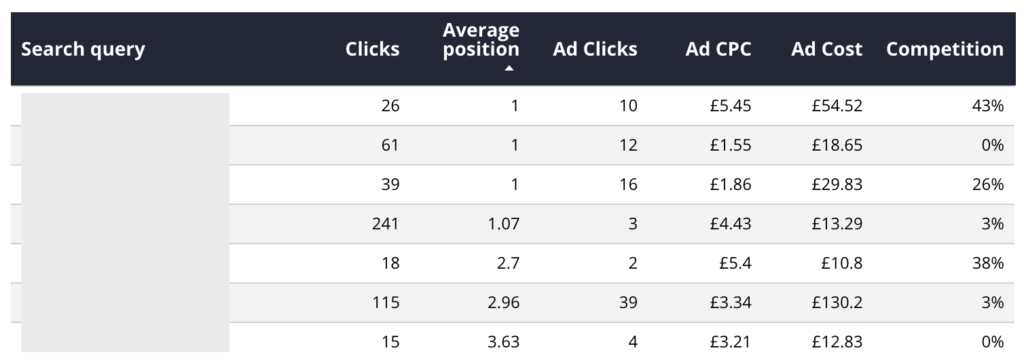
3. Review which paid keywords being bid on are driving the most conversions to make more focused SEO decisions
If you realise that a group of PPC keywords are driving a lot of conversions, but your website is not ranking at all for those terms organically, then you might want to consider creating landing pages or pieces of informational content, depending on what stage of the funnel the keyword(s) are.
Again, you can combine Google Search Console average ranking and click data alongside PPC stats in Google Data Studio to pull out these insights.
Also, by creating a specific landing page that is optimised for these keywords, the paid media team could potentially test using those as landing pages for the particular terms you uncovered initially, with the benefit of increasing quality scores, and possibly CTRs and conversion rates.
4. “Plug the gap” with poor organic performance using PPC campaigns
On the other hand, you may have a set of important, high intent keywords where there is still a lot of work to do organically before you expect to start seeing the results you’re looking for, and you are not currently running paid Ads for them. In this case, you could set up Ads for these keywords to ensure you have visibility in the SERPs. This could also be seen as a bit of a testing bed for performance. If you launch a PPC campaign for a set of keywords that you want to rank for organically, but then they do not convert well – perhaps they’re not the best keywords to be focusing on from an organic perspective after all? Or, perhaps you need to do some significant work on improving the UX of your landing pages or website as a whole?
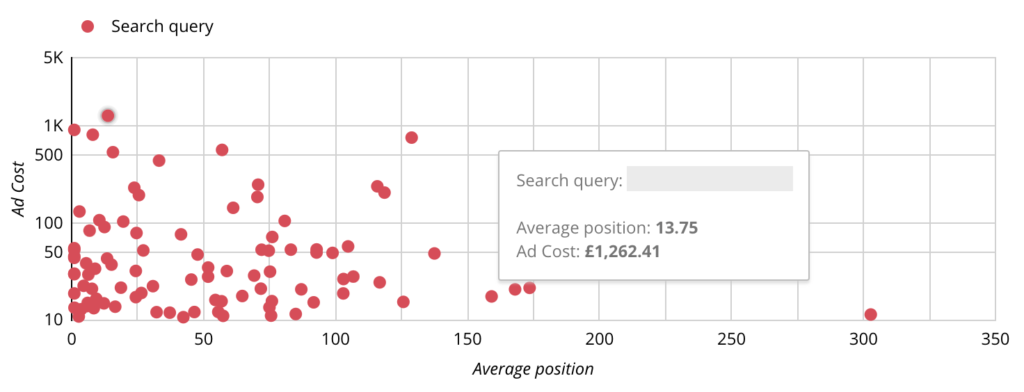
5. Use top-performing ad copy to test new metadata to increase organic click-through rates
A title tag and meta description is your chance to project a marketing message and entice a click-through. It is your “billboard” in the search results. By looking at PPC data for what is converting well (or producing a high click-through rate), you can see what might work well from an SEO perspective. Too often, I’ve seen title tags and meta descriptions that appear to have been thrown together, probably at the end of the site design, often without thought for how well they may perform in the SERPs. These are then left to languish indefinitely without any plan for ongoing review or testing. However, by using ready-tested PPC data, you can see before you launch a site what is or isn’t working. And then once a site is live, you can review click-through rate performance across titles, metas and ad copy, to further hone your messaging across both paid and organic.
How to establish unified reporting across PPC and SEO
At Hallam, we’ve created our own bespoke external and internal-facing Google Data Studio dashboards so that the teams have the data they need at their fingertips. Our client-facing reports include overall stats as well as channel breakdowns, so clients understand the performance of search as a whole. Some clients find this very useful when reporting on overall digital performance at board level – instead of having to break down into service-specific results for paid media, or SEO, they can report more easily on how search is performing as a whole, without having to get into nitty-gritty conversations about individual channels when it’s not necessary, especially when they are trying to get budget signed off!
Below are some screenshots from our bespoke Google Data Studio reports:
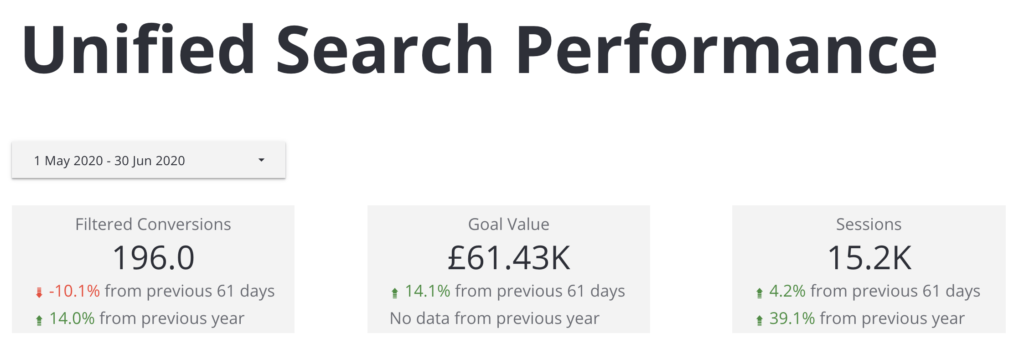
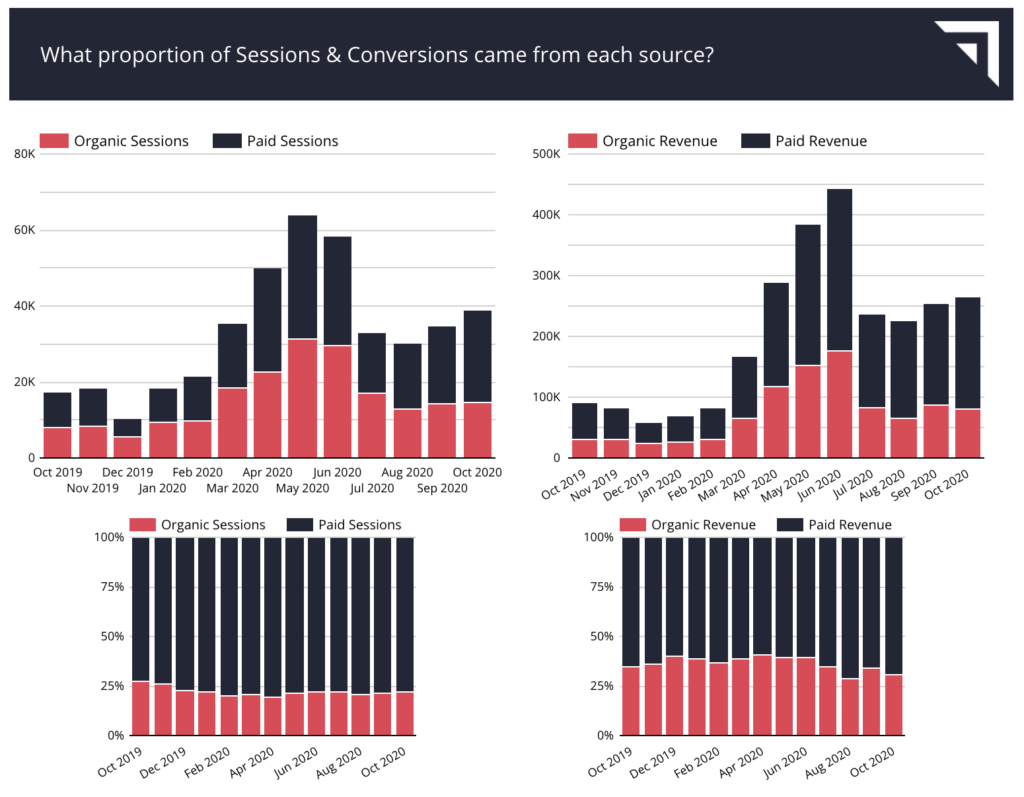
What are the benefits of this kind of integration?
Some key benefits of integrating SEO and PPC include:
- Cost-savings over time
- Increased effectiveness of campaigns
- Greater clarity of reporting and understanding where to invest budget
How often should you be reviewing this data?
We’ve found that this doesn’t need to be a daily or even weekly exercise – it’s more like a monthly review to plan in actions for the following month. It can also be useful to review as part of quarterly strategy review or reset.
Google updates that could impact this approach
It’s worth bearing in mind Google’s September 2020 update. Essentially Google has made changes to the Google Ads search terms report to only include terms “that were searched by a significant number of users”. Some early analysis by industry experts has suggested this could mean losing 28% of a campaign budget’s search term visibility.
Alongside the obvious impact on PPC specialists not being able to filter out irrelevant negative keywords as effectively, for example, it also means that some of the data that SEOs may have found useful for uncovering information about customer search intent and long-tail/low volume content ideas may now not be accessible if there were too few searches for Google to deem it “significant”.
This update drives home the need for teams to work even more closely together, sharing whatever data they can get their hands on in a useful way and collaborating on workarounds where there may be gaps.
How can PR & content marketing teams use PPC data?
Digital PR and content are integral components of any SEO strategy, and SEO, PR & Content teams tend to work closely together and share data by default. I’ve written a lot so far about how SEO and PPC specialists can work together and share insights, but how can a PR team specifically utilise this goldmine of data?
1. Using data from the placement reports in Google Ads to help build audience personas & outreach lists
If you are running display campaigns, the placement report can show you where your visitors arrived from, and how engaged they were with your site. This is useful for building up a better picture of your target audience. You may find some of these sites are sending you traffic and conversions, so you may want to include these in any outreach campaign to get an editorial placement to accompany your PPC ads.
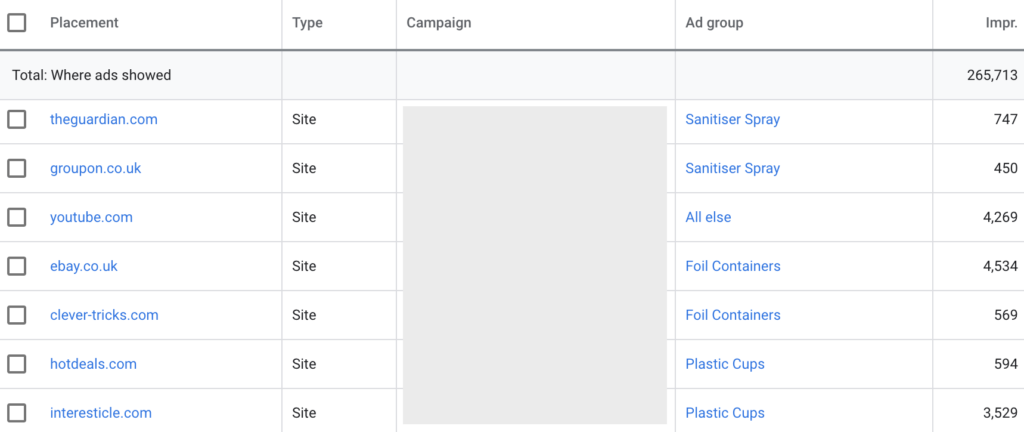
2. Utilise detailed demographic data to create content that better caters to your target customers
Based on cookie data from partner sites, Google Ads provides demographic data at impression and click level. This can be useful to see what kind of audience you are attracting to the site. When putting together content marketing strategies, this data can be used to build out customer personas, for example below you can see the audience age spread is quite even but weighted to the 35-54 age group:

Integration is the way forward
Combining and sharing data across teams is a helpful way of encouraging specialists to truly integrate their ways of working. We’ve found that the insights we gain from these reports are helpful in terms of optimising campaigns more effectively (as detailed above) but as important is the culture they help to promote. Instead of being solely obsessed with “organic results” or “paid results”, and insularly focusing on how you can use channel-specific data for your own silo-ed campaigns, this approach gets account teams talking, and has encouraged people to share their ideas & suggestions outside of their specific area of expertise.
Do you want Team Hallam on your side?
Get in touch to arrange an informal chat and learn how our experts can help your business to thrive online.


